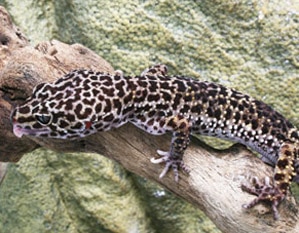Click: Emperor Scorpion, Pandinus imperator, Care – Part 1, to read the first part of this article.
Heat, Humidity and Light
 Temperature should be maintained at 78-86 F, and humidity at 70-85%. Do not cover the terrarium’s top with plastic in order to increase humidity, as air circulation is desirable. Rather, use a moisture-retaining substrate (please see above) and spray frequently with de-chlorinated water (the substrate should be slightly moist to the touch).
Temperature should be maintained at 78-86 F, and humidity at 70-85%. Do not cover the terrarium’s top with plastic in order to increase humidity, as air circulation is desirable. Rather, use a moisture-retaining substrate (please see above) and spray frequently with de-chlorinated water (the substrate should be slightly moist to the touch).
In order not to disturb your scorpions at night, heat should be provided by an incandescent “nocturnal” bulb; this will also allow you to observe your pets when they are most active. A ceramic heater may also be used.
Due to peculiarities in molecular structure of the exoskeleton, scorpions fluoresce under UVB light. Despite having discovered this in the 1940’s, scientists cannot as yet determine why such a facility should exist. The fluorescent sheen they exhibit is quite unearthly…a UVB-lit scorpion exhibit that I maintained at the Bronx Zoo has long been a favorite of visitors. Try lighting your scorpions with a UVB bulb at night…and while you’re at it, please see if you can find out what is going on with their fluorescence!
Feeding
Scorpions should be offered a wide range of soft-bodied invertebrates, including crickets, roaches, waxworms, silkworms and butterworms; some individuals will accept earthworms as well. Do not rely on crickets as a dietary mainstay; rather, provide as much variety as possible. In the warmer months, I feed mine mainly on wild caught moths, earwigs, caterpillars, katydids, crickets and soft-bodied beetles (Zoo Med’s Bug Napper is an excellent insect trap).
Emperor scorpions take readily to tong feeding , and should be provided with canned grasshoppers and silkworms as a means of increasing dietary variety. We know nothing of their vitamin/mineral needs…I powder my scorpions’ food once weekly with a reptile dietary supplement as “insurance”.
Emperor scorpions may on occasion take small frogs, lizards and even nestling rodents in the wild. This is almost certainly a rare event…vertebrate food is not required in captivity.
Water should be provided in a shallow, easily-exited water bowl.
Social Grouping/Compatible Species
Emperor scorpions present the opportunity for fascinating studies in the evolution of social behavior. Despite being as close to “living dinosaurs” as we are likely to see, these ancient animals exhibit complex social behaviors. In the wild, they often live in discreet groups that occupy a single, extensive system of burrows. We know little about the functioning of these groups. The young of emperor and other highly social scorpions remain dependent upon their mothers for longer than do other species, but other than that, specific details are lacking.
As emperor scorpions readily exhibit natural behaviors when properly housed in captivity, the research potential for interested hobbyists is enormous. I urge you to seriously consider working with this fascinating creature.
Captive groups almost always co-exist peaceably, provided they are given ample space and hiding/burrowing areas. Females that breed in group situations require special attention…I’ll address this in an article on reproduction shortly. Emperor scorpions will attack and/or consume other types of scorpions.
Further information and references to papers on emperor scorpions is posted at
 That Reptile Blog – Reptile, Amphibian and Exotic Pet Care and Information
That Reptile Blog – Reptile, Amphibian and Exotic Pet Care and Information

 Writing in the current issue of the journal Animal Behavior, researchers from the University of Grenada report that female Mexican lance-headed rattlesnakes frequently consume infertile eggs and non-living young after giving birth. This is said to be the first documented case of cannibalism among rattlesnakes (please see below for my observations, however). Interestingly, with a sole exception, the females did not consume young that were born alive, even though these remain inactive for several hours after birth, and appear (to us, at least!) to be dead.
Writing in the current issue of the journal Animal Behavior, researchers from the University of Grenada report that female Mexican lance-headed rattlesnakes frequently consume infertile eggs and non-living young after giving birth. This is said to be the first documented case of cannibalism among rattlesnakes (please see below for my observations, however). Interestingly, with a sole exception, the females did not consume young that were born alive, even though these remain inactive for several hours after birth, and appear (to us, at least!) to be dead. I had the wonderful opportunity of participating in the renovation of the Staten Island Zoo’s reptile house, former stomping ground of legendary snakeman Carl Kauffeld (known to all snake keepers as the author of Snakes, the Keeper and the Kept and Snakes and Snake Hunting).
I had the wonderful opportunity of participating in the renovation of the Staten Island Zoo’s reptile house, former stomping ground of legendary snakeman Carl Kauffeld (known to all snake keepers as the author of Snakes, the Keeper and the Kept and Snakes and Snake Hunting). The ever popular leopard gecko is a good choice as an introduction to the breeding of lizards in captivity. Success, while not assured, is common…yet, these little fellows are so captivating that even zoos and well-experienced breeders continue to work with them.
The ever popular leopard gecko is a good choice as an introduction to the breeding of lizards in captivity. Success, while not assured, is common…yet, these little fellows are so captivating that even zoos and well-experienced breeders continue to work with them. The African bullfrog pictured here may be seen in the wonderful amphibian exhibit area at
The African bullfrog pictured here may be seen in the wonderful amphibian exhibit area at